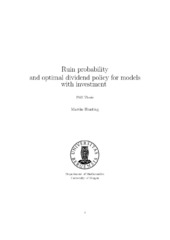Ruin probability and optimal dividend policy for models with investment
Doctoral thesis
Permanent lenke
https://hdl.handle.net/1956/6213Utgivelsesdato
2012-11-06Metadata
Vis full innførselSamlinger
Sammendrag
In most countries the authorities impose capital requirements on insurance companies in order to avoid the adverse consequences to society when insurance companies default on claims. Since holding capital is costly, this naturally leads to the problem of deciding how large the risk reserve needs to be, or what is a "safe" level of liquidity. A common answer is that the probability that the insurance company will default on policyholder claims should not be higher than a certain small level Є. An implementation of this policy requires reasonably accurate methods for determining this probability, known as the ruin probability. Rigorous mathematical treatments of the ruin probability problem can be traced at least as far back as the acclaimed doctoral thesis of Filip Lundberg from 1903 with the title "Approximerad framställning af sannolikhetsfunktionen". Traditionally the focus has been on ruin probability on an infinite time horizon. In these models an insurance company can avoid ruin by allowing its risk reserve to grow toward infinity. At the 15th International Congress of Actuaries in 1957 Bruno de Finetti criticized this approach. In particular he couldn't see why an older company should hold more capital than a younger one bearing similar risks, only because it is older. As an alternative de Finetti formulated what is known as the "de Finetti’s dividend problem": Maximizing the expected sum of the discounted paid out dividends from time zero until ruin. Since then several papers have presented solutions to this problem for various risk processes. Two of the papers in this thesis, which we denote Paper A and Paper B, focus on de Finetti’s dividend problem, with the risk process following a general diffusion and a jump-diffusion process, respectively. These models are particularly relevant for insurance companies where the premium income is invested in assets with stochastic returns. In keeping with de Finetti’s original paper, where ruin probability played a central role, Paper A also discusses solutions of de Finetti’s dividend problem under solvency constraints. In the last few decades a growing number of papers have focused on ruin probability on a finite time horizon. For short time spans the assumption that the risk reserve is allowed to grow freely is less spurious. An important tool for calculating the ruin probability on a finite horizon is solving certain partial integro-differential equations (PIDEs). The third paper, denoted Paper C, discusses how these PIDEs can be solved numerically. The last paper, denoted Paper D, discusses regularity properties for some of these PIDEs.
Beskrivelse
In the electronic version of the thesis the published version of paper I has been replaced with the accepted version.
Består av
Paper A: L. Bai, M. Hunting and J. Paulsen (2012). Optimal dividend policies for a class of of growth-restricted difusion processes under transaction costs and solvency constraints. Published in Finance and Stochastics, July 2012, Volume 16, Issue 3, pp 477-511. The paper is available at: http://hdl.handle.net/1956/6226Paper B: M. Hunting and J. Paulsen (2012). Optimal dividend policies with transaction costs for a class of jump-diffusion processes. To appear in and accepted by Finance and Stochastics. The paper is available at: http://hdl.handle.net/1956/6214
Paper C: M. Hunting (2012). A numerical approach to ruin probability infinite time for fitted models with investment. Not submitted. The paper is available at: http://hdl.handle.net/1956/6224
Paper D: M. Hunting (2012). Existence of a classical solution of a parabolic PIDE associated with ruin probability. Not submitted. The paper is available at: http://hdl.handle.net/1956/6225
